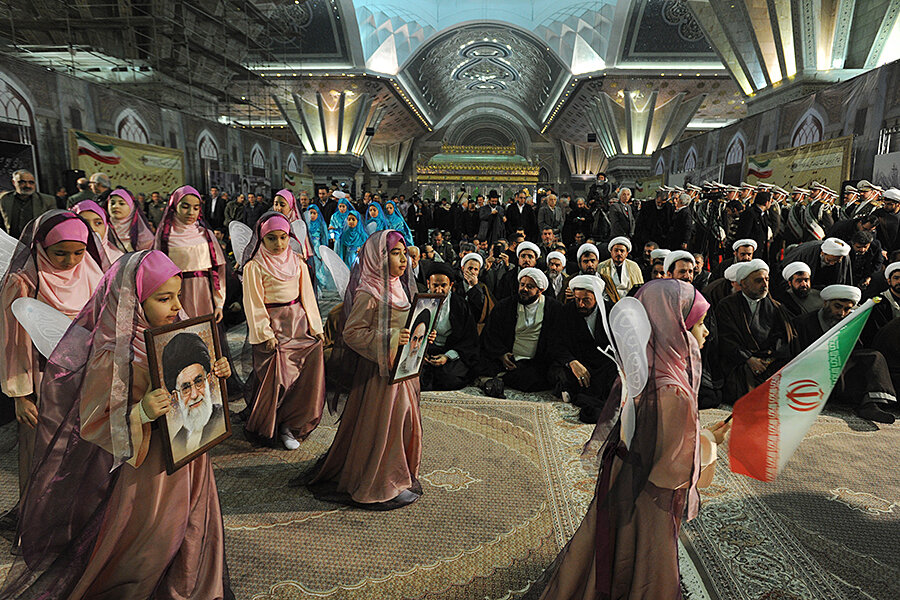In Iran, fierce political winds buffet a grandson of the revolution
Loading...
| Tehran and Qom, Iran
Official veneration of Ayatollah Ruhollah Khomeini, the founder of Iran’s 1979 revolution, is as natural as breathing in the Islamic Republic.
So Monday’s ceremony marking the anniversary of Mr. Khomeini’s return from exile was larger than life. It began at 9:27 a.m., the moment the black-turbaned cleric set foot on Iranian soil 37 years ago.
In the vast gilt-domed shrine housing Khomeini’s remains south of Tehran, girls wearing wings and boys in taekwondo outfits waved Iranian flags. Amid chants of “Death to America,” officials, clerics and police and military units knelt on the carpeted floor to reaffirm their revolutionary path.
Surprisingly missing from the pageantry, however, was the ayatollah’s grandson in charge of the shrine, Seyyed Hassan Khomeini, who despite his grandfather’s colossal legacy has been caught up in political maneuvering by hard-liners ahead of elections this month.
The younger Mr. Khomeini’s followers laud him as a “keepsake of the Imam,” using the highest honorific title in Shiite Islam for his famous grandfather. But in a move that has caused an uproar, he has been disqualified as a candidate for the Assembly of Experts, the 88-member body that could choose Iran’s next supreme leader.
Elections for the Assembly are being held Feb. 26 alongside voting for a new parliament. In a measure of Iran’s deep political divisions, 99 percent of the 3,000 reformists trying to get into parliament have been barred from running by the Guardian Council.
Khomeini’s followers hoped the return of the Khomeini brand to politics could be a unifying influence. But attacks have been fierce from entrenched hard-liners who despise the 43-year-old mid-ranking cleric’s closeness to centrists and reformists.
For years Khomeini’s descendants were off-limits to criticism. Yet in Iran’s polarized politics this once-sacred rule has largely dissolved, and the ensuing battle has sharpened Iran’s political divisions.
“When important figures like Seyyed Hassan Khomeini get disqualified, there is no hope,” says Grand Ayatollah Yusef Saanei, a reformist who was very close to the elder Khomeini, in an interview in Iran’s holy city of Qom.
Mr. Saanei says he was “100 percent sure” Khomeini would be disqualified, because he “is the one who has qualities to be the leader” in the future, and some wanted to prevent that.
Conservative backlash
Some analysts speculate that a powerful troika inside the assembly that would include Khomeini, centrist President Hassan Rouhani, and former President Akbar Hashemi Rafsanjani – who asked Khomeini run for the assembly – could seek to determine a more moderate future leader.
That prospect has prompted a conservative backlash. Hossein Shariatmadari, editor of Kayhan newspaper, says the Khomeini name is being used to “hide the plans of the troublemaker groups,” and that the “filthy trend” – meaning reformists – set a “dangerous trap” for him.
Hard-line Ayatollah Mesbah Yazdi said “enemies” were “trying to hold a referendum to dismiss the supreme leader.” Others accuse Mr. Rafsanjani of wanting a “new seditious movement.”
But Mojtaba Mousavi, the conservative editor of the Iran’s View website, says hard-liners are making a mistake. “By criticizing [Khomeini] they push him toward the reformists. They helped the reformists absorb him, and say: ‘You see, the grandson of Imam Khomeini is one of us,’ ” he says.
“The majority of people love Imam Khomeini, so they won’t like the people who criticize him,” says Mr. Mousavi.
Hard-liners challenged
Rafsanjani blasted the rejection of Khomeini, whom he called “the most similar to his grandfather,” and challenged the hard-liners’ near monopoly on powerful positions.
“Who allowed you to judge?” asked the two-time president about Khomeini’s opponents. “Who allowed you to take control of parliament? … Who allowed you to own weapons and … all [Friday] prayers’ speaking positions and [state] broadcasting? Who gave you all this?”
Rafsanjani said none of it would have existed without Khomeini and the public’s revolutionary will, and that the disqualification “gave a bad gift to Imam’s family.”
Over the weekend, in an annual ritual, the supreme leader, Ayatollah Ali Khamenei, visited the shrine alongside Khomeini. So too did Mr. Rouhani and his entire cabinet, in a show of political support.
Khomeini praised Rouhani as a “soldier of the Imam’s path.” Rouhani tweeted an image of their meeting.
Khomeini 'brand' weakened?
But the younger Khomeini has felt the sting of critics, who accuse him of betraying his grandfather’s legacy.
It first began in 2008, when a hard-line website said Khomeini received a $75,000 BMW and lived in luxury in north Tehran, where he would “never leave” his steam sauna but “have the luck to see the problems of the poor and needy with [his flushed] red cheeks.”
“The Khomeini family I think is now far from people,” says a conservative journalist in Qom who asked not to be named. “Inside the holy shrine it is like a palace. Many people protest and said [Ayatollah Khomeini] was a man who lived very simply, but his shrine is like a pharaoh’s.”
As to the Khomeini brand, a veteran analyst in Tehran who asked not to be named says it has been “very much” diluted.
“There was a time when nothing could touch them, everything was sacred about this,” he says. “But because the family leaned toward the reformists and centrists … people learned that in politics everything can change. You may have the Khomeini name, but you are out.”
A final decision on whether he can stand for the Assembly is due in two weeks.








